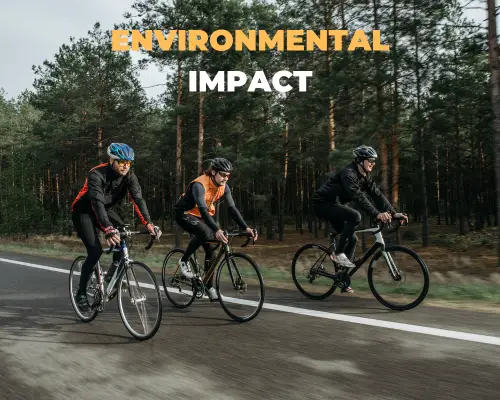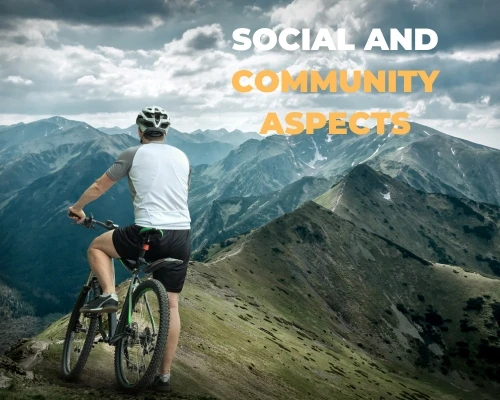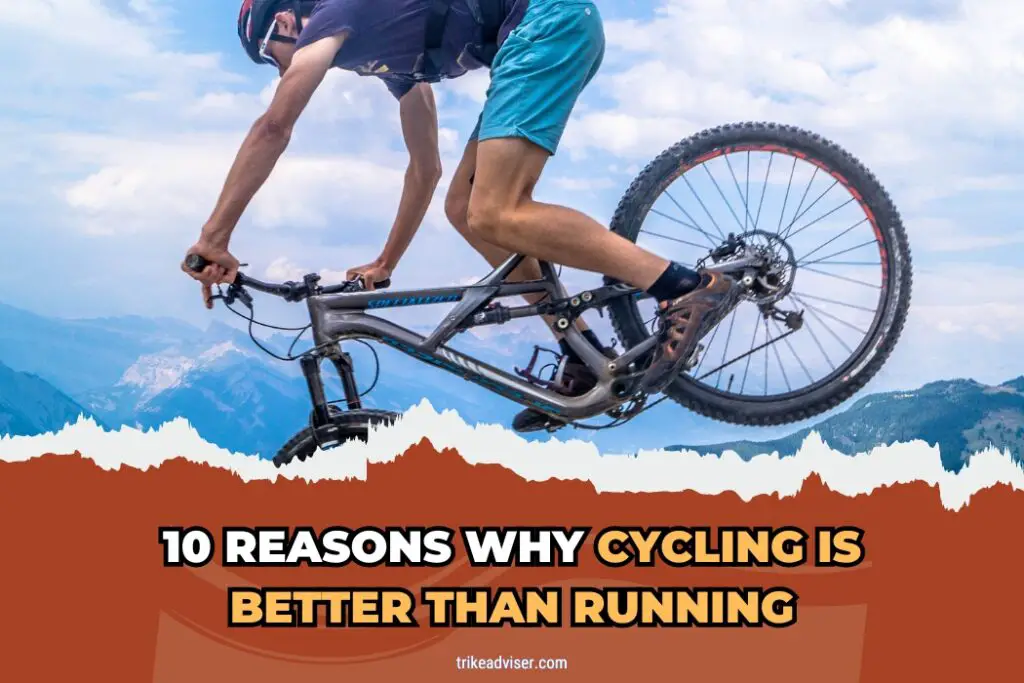10 Reasons Why Cycling Is Better Than Running? You might think it’s just about preference. It’s not. Consider the common gripes with running: joint pain, accessibility, monotony. Sound familiar? Then there’s cycling. A world where the road stretches wide and possibilities are endless.
Ever felt the dread of pounding pavement, one step after another? That’s running’s reality for many. Cycling, however, offers an escape. A seat, two wheels, and you’re off. Speeding past landscapes, the wind in your face, no heavy impact on your knees.
It’s not just exercise; it’s an adventure. Worried about starting? Think it’s too late? It’s never too late. Bikes come in all shapes, sizes, tailored for every rider.
Ready to explore why cycling holds the upper hand? Let’s dive in. Remember, it’s not about the destination; it’s about the journey. And what a journey it promises to be.
10 Reasons Why Cycling Is Better Than Running
Fewer Injuries
Cycling stands out with its promise of fewer injuries. Unlike running, cyclists rarely face shin splints, runner’s knee, or stress fractures. It’s the gentler choice for your body, offering a safer path to fitness and endurance.
More Fun and Varied Disciplines
From the exhilaration of downhill riding to the endurance needed for road biking, cycling brings a spectrum of disciplines. Each offers unique challenges, making every ride an adventure. This variety keeps boredom at bay, unlike the often monotonous nature of running.
Better Destinations
Imagine cycling through serene mountain ranges or rustic rural scenes. Cycling unlocks doors to diverse and breathtaking destinations worldwide. These scenic journeys offer more than just exercise; they’re an exploration of the beauty around us.
Low Impact
Cycling’s low-impact nature makes it a sustainable sport for many. It spares your joints the harsh pounding of running. This gentleness supports longer, more frequent sessions without the risk of injury, promoting long-term health and fitness.
Ability to Travel Farther
With a bike, the world opens up. Cover vast distances and discover hidden corners of your city or unexplored trails. Cycling offers a unique sense of adventure, far surpassing the limited range of running.
Speed
There’s a thrill in the speed cycling can achieve, especially when descending. This aspect of cycling caters to those who crave speed, offering an exhilarating experience that running simply can’t match.
Cooler Apparel
Cycling gear blends functionality with style. The vibrant, bold designs of cycling apparel allow for personal expression. This not only enhances the cycling experience but also adds an element of fashion to the sport.
Efficient Means of Transportation
Swap your sedentary commute for a cycle ride. Cycling is not just exercise; it’s a practical, eco-friendly means of transportation. It transforms travel time into an opportunity for health benefits, making it a smart choice for daily routines.
Social Aspects
Cycling thrives on camaraderie. Whether it’s a leisurely mid-ride coffee stop or a challenging group ride, cycling fosters social connections. It’s a sport that brings people together, creating a supportive community of enthusiasts.
Technical Advantages

Gear and Equipment
Essentials Make the Ride: Choosing your bike is the start. Road racing or mountain biking? Decide. Clothing matters too. Moisture-wicking fabrics and proper shoes change the game. And safety? Helmets, lights, reflective gear are must-haves. Visibility is key, especially at night.
Cycling Techniques for Beginners
Getting Basics Right: Start with these:
Bike Fit: It should match your frame. Wrong size? Discomfort follows.
Pedaling: It’s about circles, not just pushing down. Energy efficiency peaks.
Gear Shifting: Climb easier, descend safer. Knowing when and how is crucial.
Braking: Smooth stops, safer turns. Essential skill.
Position: Relaxed but engaged. Adjust for the ride ahead.
Basics lead to comfort, efficiency, safety.
Safety Gear and Practices
Safety Can’t Be Overstated: Key points include:
Helmets: A minor scare or a serious injury? Helmets often decide.
Visibility: Lights and reflective clothing. Make sure drivers see you.
Rules of the Road: Signals and alertness matter. Safety for all on the road.
Environmental Impact

Reducing Carbon Footprint
Cycling Over Cars: A simple choice, profound impact. Opting for a bike over a car cuts CO2 drastically. Cars emit tons of carbon annually; bikes, nearly zero. Each pedal turn is a step towards a healthier planet. Air quality benefits, temperatures might stabilize, and our carbon footprint shrinks. It’s action within everyone’s reach, contributing to a greener world.
The Role of Cycling in Urban Planning
Cities Evolving: Urban spaces are transforming, all thanks to cycling. Bike lanes and paths are becoming staples of city planning. This shift not only makes cycling safer but also encourages more to join. Result? Less traffic, cleaner air, and a vibrant, active community. Cycling-friendly cities are leading by example, showing a path to sustainability. Through thoughtful planning, urban areas worldwide are becoming havens for cyclists and, by extension, healthier environments for all residents.
Social and Community Aspects

Joining Cycling Clubs
Ride Together, Grow Together: The power of group rides is undeniable. Here’s why:
Accountability & Motivation: It’s easy to hit snooze on an alarm. Harder when friends await.
Learn and Share: Every ride is a chance to gain new skills. From fixing a flat to mastering steep climbs, wisdom is shared freely.
Safety in Numbers: A group is easier to spot than a lone cyclist. Risks diminish.
Community Feel: Bonds form on these rides. Shared struggles and triumphs knit cyclists closely together.
Cycling Events and Races
Beyond the Ride: Events and races offer more than just competition.
Charity Rides: Ride for a cause. These events unite cyclists with a shared goal beyond personal bests. Funds are raised, awareness grows, and communities benefit.
Community Rides: Join one, feel the camaraderie. Age or skill doesn’t matter here; passion for cycling does. It’s about the joy, shared over miles of shared paths.
Organized Events: Test your limits. Set personal goals. But, it’s more than that. Meeting others, exchanging stories, and celebrating milestones mark these events.
Independent Challenges: Organize a ride for a cause close to your heart. It’s a dual win; personal achievement meets societal benefit.
Cycling Gear and Apparel
Choosing the Right Bike
Tailored to Your Journey: Finding your perfect ride is key. Consider these:
Cycling Type: Road? Mountain? Commute? Your choice shapes the bike you need.
Fit is Key: A wrong fit means discomfort, even injury. Frame size to handlebar reach, it all matters.
Set Your Budget: Quality matters, but so does affordability. Don’t forget to factor in gear and upkeep costs.
Durability Counts: Frequent rides or rough trails demand sturdy materials. Longevity saves money over time.
Research Thoroughly: Dive into reviews, seek seasoned advice. The right brand makes a difference.
Accessorizing Your Ride
Enhance Every Mile: The right accessories make every journey smoother.
Safety First: Helmets are non-negotiable. A proper fit protects during falls.
Dress the Part: Jerseys, shorts, gloves. Look for moisture-wicking, breathable fabrics for comfort and performance.
Be Seen: Lights and reflective gear are essentials for visibility, day or night.
Ready for Anything: A repair kit with the basics covers most road surprises.
Hydration is Key: A water bottle and cage are must-haves for access to fluids on the go.
Track Your Progress: A cycling computer offers insights into speed, distance, and more. Useful for goal setting and tracking improvements.
Optional Extras: Customizing with saddlebags, locks, shoes, or sunglasses adds functionality and style to your ride.
As an Amazon Associate, I earn from qualifying purchases, at no additional cost to you. Read Our Affiliate Disclosure.

